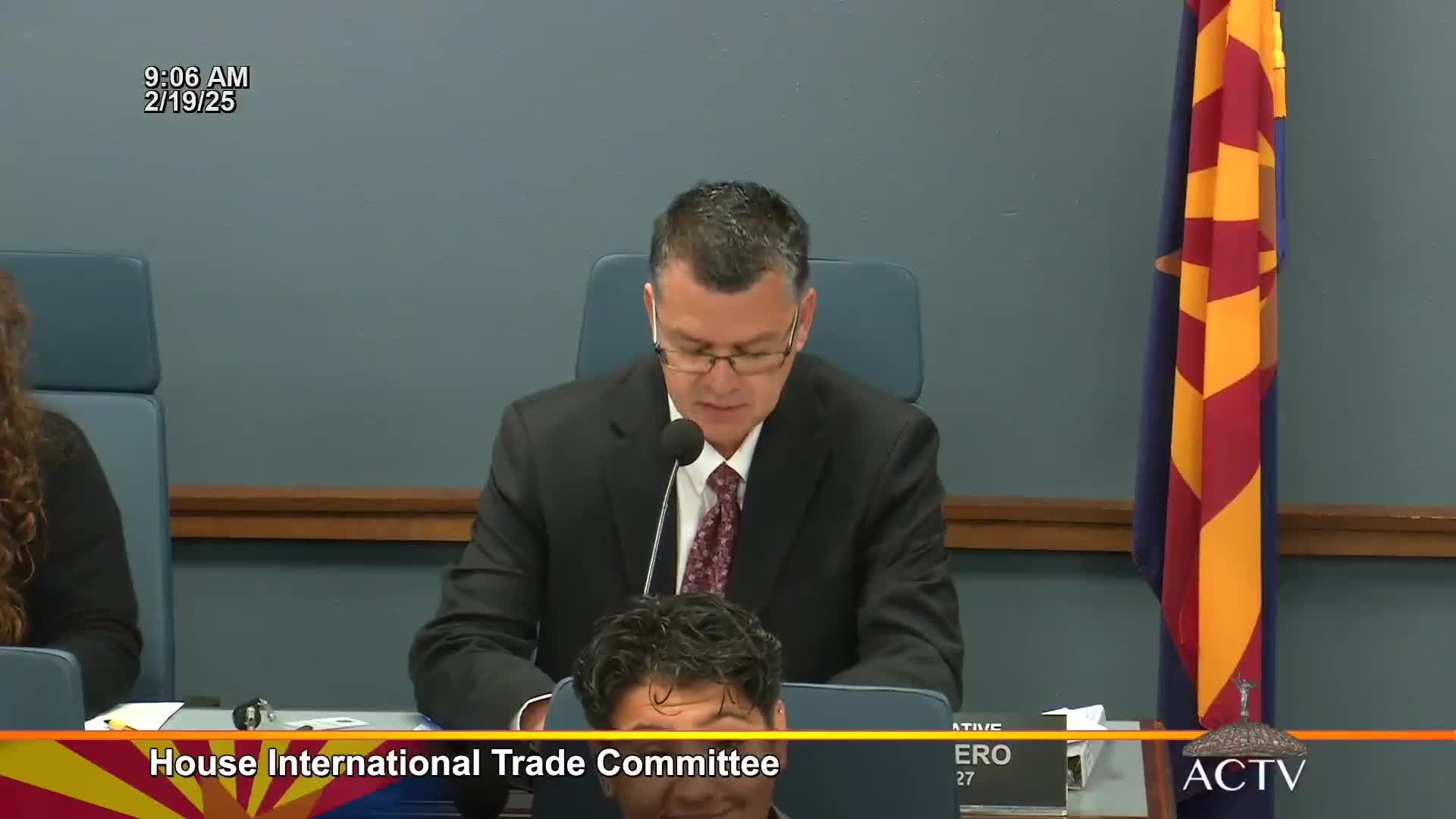Arizona Hispanic Chamber presents market data showing trade ties, consumer purchasing power and gaps in business revenues
February 19, 2025 | 2025 Legislature Arizona, Arizona
This article was created by AI summarizing key points discussed. AI makes mistakes, so for full details and context, please refer to the video of the full meeting. Please report any errors so we can fix them. Report an error »

Monica Villalobos, president and chief executive officer of the Arizona Hispanic Chamber of Commerce, told the Legislature's International Trade Committee that Hispanic households and businesses are a major economic force for the state and that the Chamber stands ready to provide market intelligence for lawmakers.
Villalobos said the chamber, founded in 1948, serves small businesses statewide and counts 106 corporate partners. "We are committed to providing you relevant, responsible, and reliable data, that you can then use informing your legislation," she said.
Paul Padilla, the Chamber's senior director of market intelligence, presented slides showing demographic and trade measures that committee members said underline why the committee's work matters. Padilla highlighted national and state-level figures: roughly 63,600,000 Hispanics in the U.S.; U.S. Latino purchasing power estimated at $2.1 trillion; and an overall U.S. Latino GDP estimate cited at about $3.7 trillion. In Arizona, he said, Hispanics make up about 30% of the state population, about 40% of the Phoenix metropolitan area and roughly 50% of K''12 enrollment, and contribute an estimated $70 billion to the state economy.
The presenters traced trends in trade and foreign direct investment. The Chamber noted that Arizona's imports rose from about $25 billion in 2020 to about $42 billion in 2024, and exports from about $20 billion to about $32 billion in the same period. Padilla cited a U.S. Department of Commerce figure that as of August 2024, 40,600 Arizona jobs were supported by majority-foreign-owned affiliates and that 266 FDI projects had been announced in the state.
Villalobos and Padilla also showed survey results the Chamber published: a February 2022 quantitative study of minority-owned businesses in Arizona, Nevada and Utah. The presenters said 51% of minority-owned businesses surveyed were family owned and about 19% reported engaging in international trade, with approximately 40% of that trade going to Mexico.
On education and workforce, Padilla pointed to disparities in K''12 academic ratings: 68% of white-dominant schools were shown as A-rated in the Chamber's analysis, compared with 16% of Latino-dominant schools. Villalobos and Padilla framed these findings as context for future workforce development and economic policy.
Committee members asked for a summary of current business challenges and opportunities. Villalobos cited three priorities identified by businesses: workforce availability, public safety and supply-chain resilience. "Workforce, access to be able to have a workforce to deliver the product," she said. "Supply chain is really kind of the big one. Can we get the products and the components necessary to put out our particular product or service?"
The chamber offered itself as an information resource to lawmakers and staff for drafting and testing legislation with demographic and trade data.
Villalobos and Padilla's presentation, committee members said, calls attention to economic growth tied to Hispanic consumers and businesses, while also flagging measurable gaps in revenue generation, school outcomes and workforce readiness that could affect future trade and economic policy.
Villalobos said the chamber, founded in 1948, serves small businesses statewide and counts 106 corporate partners. "We are committed to providing you relevant, responsible, and reliable data, that you can then use informing your legislation," she said.
Paul Padilla, the Chamber's senior director of market intelligence, presented slides showing demographic and trade measures that committee members said underline why the committee's work matters. Padilla highlighted national and state-level figures: roughly 63,600,000 Hispanics in the U.S.; U.S. Latino purchasing power estimated at $2.1 trillion; and an overall U.S. Latino GDP estimate cited at about $3.7 trillion. In Arizona, he said, Hispanics make up about 30% of the state population, about 40% of the Phoenix metropolitan area and roughly 50% of K''12 enrollment, and contribute an estimated $70 billion to the state economy.
The presenters traced trends in trade and foreign direct investment. The Chamber noted that Arizona's imports rose from about $25 billion in 2020 to about $42 billion in 2024, and exports from about $20 billion to about $32 billion in the same period. Padilla cited a U.S. Department of Commerce figure that as of August 2024, 40,600 Arizona jobs were supported by majority-foreign-owned affiliates and that 266 FDI projects had been announced in the state.
Villalobos and Padilla also showed survey results the Chamber published: a February 2022 quantitative study of minority-owned businesses in Arizona, Nevada and Utah. The presenters said 51% of minority-owned businesses surveyed were family owned and about 19% reported engaging in international trade, with approximately 40% of that trade going to Mexico.
On education and workforce, Padilla pointed to disparities in K''12 academic ratings: 68% of white-dominant schools were shown as A-rated in the Chamber's analysis, compared with 16% of Latino-dominant schools. Villalobos and Padilla framed these findings as context for future workforce development and economic policy.
Committee members asked for a summary of current business challenges and opportunities. Villalobos cited three priorities identified by businesses: workforce availability, public safety and supply-chain resilience. "Workforce, access to be able to have a workforce to deliver the product," she said. "Supply chain is really kind of the big one. Can we get the products and the components necessary to put out our particular product or service?"
The chamber offered itself as an information resource to lawmakers and staff for drafting and testing legislation with demographic and trade data.
Villalobos and Padilla's presentation, committee members said, calls attention to economic growth tied to Hispanic consumers and businesses, while also flagging measurable gaps in revenue generation, school outcomes and workforce readiness that could affect future trade and economic policy.
View full meeting
This article is based on a recent meeting—watch the full video and explore the complete transcript for deeper insights into the discussion.
View full meeting
